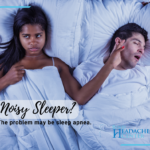Snoring is more than just an annoying sound – it can be the sign of an underlying, life-threatening condition known as obstructive sleep apnea (OSA). Up to 90 million Americans snore at some point, and about half of them suffer from this breathing disorder. OSA is a serious problem that can lead to other ailments such as heart disease, Alzheimer’s and even death. Unfortunately, people with OSA may not realize they have the issue because the symptoms are difficult to detect.
Thankfully, advances in technology and medicine have made the diagnosis and treatment of sleep apnea much easier. Home sleep studies provide quick insight into potential issues, while CPAP machines have become smaller, quieter and more comfortable in recent years. Alternative treatments, such as mandibular advancement devices, are available if CPAP machines prove unsuitable or undesirable for the patient. With proper testing and treatment, it’s possible for anyone suffering from OSA to find relief and peace of mind.
How Serious Is Sleep Apnea?
The severity of sleep apnea can vary widely from person to person, but it is important to take the condition seriously. Left untreated, OSA can lead to a variety of health problems, such as hypertension (high blood pressure), stroke, heart attacks, cardiovascular disease and even death. Even mild cases of sleep apnea can cause daytime fatigue and impaired cognitive function. In addition to the physical risks associated with OSA, it can lead to psychological issues in people with sleep apnea, like depression and anxiety.
Sleep Apnea Symptoms
If you suspect that you or someone you know may have sleep apnea, it is important to look for common symptoms. Some of the most common signs include snoring, choking or gasping during sleep; excessive daytime fatigue; and morning headaches. People with OSA may also experience depression, irritability and difficulty concentrating throughout the day.
Keep in mind that not everyone with these symptoms has sleep apnea, so it is important to speak to a doctor if you think you may be suffering from the condition. And vice versa. Some people without these symptoms also experience breathing interruptions during sleep caused by obstructive sleep apnea.
Who Is Affected by Sleep Apnea?
Sleep apnea and other sleep-disordered breathing conditions can occur in all ages, genders and races. Men are twice as likely as women to have sleep apnea, with 3 to 7 percent of men and 2 to 5 percent of women having it. About 26 percent of adults aged 30 to 70 have obstructive sleep apnea. Of children aged 2 to 8, only 1 to 8 percent have it. The rate increases considerably with age.
Other risk factors for sleep apnea include:
- Being overweight or obese
- Having a large neck size (17 inches or greater in men and 16 inches or greater in women)
- Smoking
- Alcohol consumption
- Certain medications, such as sedatives, muscle relaxants and tranquilizers
- Family history of sleep apnea
- Asthma or allergies that block your airways
CPAP or No CPAP?
Continuous positive airway pressure (CPAP) machines are the most commonly known treatment for sleep apnea.
A CPAP machine is a device that delivers a steady stream of air pressure into the patient’s airway during sleep, preventing the airway from collapsing and leading to apneic events. The machine works by using an adjustable mask – a nasal mask that fits over the nose or a mask that fits over the nose and mouth – connected to a motorized blower that is adjusted according to the patient’s needs.
The device delivers a consistent stream of pressurized air into the user’s airway to keep it open while the patient is sleeping.
The goal of using a CPAP machine is to reduce the number of apneic events during sleep and to improve quality of life by reducing snoring, daytime fatigue and other OSA-related problems.
The Problems With CPAP Machines
While this is often a successful form of treatment, some people find the machines uncomfortable or difficult to use. CPAP machines are often loud, which makes sleeping much more difficult. And they can make wearers feel claustrophobic, which also can prevent them from getting good quality sleep.
So Should You Skip Treatment?
NO! Untreated sleep apnea is dangerous.
If you are unable to use a CPAP machine, there are several non-invasive treatment options that may be effective. Oral appliances, surgery and lifestyle changes such as weight loss, avoiding alcohol and quitting smoking can help reduce the severity of sleep apnea. Your doctor can help you find the best treatment plan for your individual needs.
Alternative Treatments for Sleep Apnea
If CPAP machines are not an option, there are alternative treatments available for sleep apnea. Mandibular advancement devices (MADs) are one of the most popular alternatives to CPAP therapy. These devices work by holding the lower jaw and tongue in a forward position during sleep, preventing the airway from collapsing and keeping apnea events at bay.
Regardless of which treatment is chosen, it’s important to speak with your doctor about any concerns you have and work together to find a solution that is right for you.

